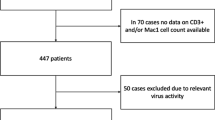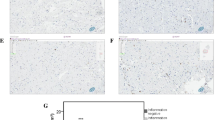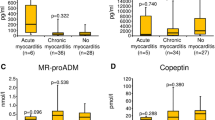Abstract
Whereas C-reactive protein (CRP) is acknowledged as a cardiovascular risk marker, there is ongoing discussion about its role as a risk factor. Previous studies focused on the effects of CRP on ischaemic heart failure and atherosclerosis. In this study we investigated distribution of CRP, the Terminal Complement Complex (C5b-9) and macrophages (CD68) in the myocardium of patients suffering from non-ischaemic heart failure and their implication on clinical parameters. Endomyocardial biopsies were taken from 66 patients suffering from dilated cardiomyopathy (DCM). Biopsies were analysed by immunohistochemical and immunofluorescent staining for CRP, C5b-9 and CD68. Viral DNA/RNA for adenovirus, enterovirus, parvovirus B19 and human herpes virus 6 was detected by PCR and Southern blot analysis. Myocardial biopsy findings were correlated with plasma level of hsCRP and NT-proBNP as well as echocardiography, exercise test and NYHA class. In 18 (27%) patients, a positive staining for CRP and in 57 (86%) patients a positive staining for C5b-9 was detected. All patients showed myocardial infiltration with macrophages with an average of 39 cells/mm2. CRP, C5b-9 and CD68 co-localised within the myocardium. No correlation was observed for inflammatory proteins and plasma level of hsCRP, NT-proBNP and clinical parameters. CRP is frequently present in the myocardium of patients suffering from DCM and co-localises with C5b-9 and macrophages. CRP may contribute to myocardial damage in DCM via activation of the complement system and chemotaxis of macrophages.



Similar content being viewed by others
References
Aretz HT (1987) Myocarditis: the Dallas criteria. Hum Pathol 18:619–624
Caforio AL, Calabrese F, Angelini A, Tona F, Vinci A, Bottaro S et al (2007) A prospective study of biopsy-proven myocarditis: prognostic relevance of clinical and aetiopathogenetic features at diagnosis. Eur Heart J 28:1326–1333
Ceconi C, Boraso A, Mele D, Guardigli R, Ferrari R (2004) TNFalpha in patients with congestive heart failure. Basic Res Cardiol 99:12–17
Cooper LT, Baughman KL, Feldman AM, Frustaci A, Jessup M, Kuhl U, Levine GN, Narula J, Starling RC, Towbin J, Virmani R, American Heart Association, American College of Cardiology, European Society of Cardiology (2007) The role of endomyocardial biopsy in the management of cardiovascular disease: a scientific statement from the American Heart Association, the American College of Cardiology, and the European Society of Cardiology. Circulation 116:2216–2233
Danesh J, Wheeler JG, Hirschfield GM, Eda S, Eiriksdottir G, Rumley A, Lowe GD, Pepys MB, Gudnason V (2004) C-reactive protein and other circulating markers of inflammation in the prediction of coronary heart disease. N Engl J Med 350:1387–1397
Fujioka S, Kitaura Y, Ukimura A, Deguchi H, Kawamura K, Isomura T, Suma H, Shimizu A (2000) Evaluation of viral infection in the myocardium of patients with idiopathic dilated cardiomyopathy. J Am Coll Cardiol 36:1920–1926
Goser S, Andrassy M, Buss SJ, Leuschner F, Volz CH, Ottl R, Zittrich S, Blaudeck N, Hardt SE, Pfitzer G, Rose NR, Katus HA, Kaya Z (2006) Cardiac troponin I but not cardiac troponin T induces severe autoimmune inflammation in the myocardium. Circulation 17:1693–1702
Griselli M, Herbert J, Hutchinson WL, Taylor KM, Sohail M, Krausz T, Pepys MB (1999) C-reactive protein and complement are important mediators of tissue damage in acute myocardial infarction. J Exp Med 190:1733–1739
Huang CH, Vallejo JG, Kollias G, Mann DL (2009) Role of the innate immune system in acute viral myocarditis. Basic Res Cardiol 21:(Epub ahead of print)
Ivashchenko Y, Kramer F, Schafer S, Bucher A, Veit K, Hombach V, Busch A, Ritzeler O, Dedio J, Torzewski J (2005) Protein kinase C pathway is involved in transcriptional regulation of C-reactive protein synthesis in human hepatocytes. Arterioscler Thromb Vasc Biol 25:186–192
Kardys I, Knetsch AM, Bleumink GS, Deckers JW, Hofman A, Stricker BH, Witteman JC (2006) C-reactive protein and risk of heart failure. The Rotterdam Study. Am Heart J 152:514–520
Kindermann I, Kindermann M, Kandolf R, Klingel K, Bültmann B, Müller T, Lindinger A, Böhm M (2008) Predictors of outcome in patients with suspected myocarditis. Circulation 118:639–648
Kishimoto C, Hiraoka Y, Takada H (2001) T cell-mediated immune response enhances the severity of myocarditis in secondary cardiotropic virus infection in mice. Basic Res Cardiol 96:439–445
Koenig W, Khuseyinova N, Baumert J, Thorand B, Loewel H, Chambless L, Meisinger C, Schneider A, Martin S, Kolb H, Herder C (2006) Increased concentrations of C-reactive protein and IL-6 but not IL-18 are independently associated with incident coronary events in middle-aged men and women: results from the MONICA/KORA Augsburg case-cohort study, 1984–2002. Arterioscler Thromb Vasc Biol 26:2745–2751
Koenig W, Sund M, Fröhlich M, Fischer HG, Löwel H, Döring A, Hutchinson WL, Pepys MB (1999) C-Reactive protein, a sensitive marker of inflammation, predicts future risk of coronary heart disease in initially healthy middle-aged men: results from the MONICA (Monitoring Trends and Determinants in Cardiovascular Disease) Augsburg Cohort Study, 1984 to 1992. Circulation 99:237–242
Kovacs A, Tornvall P, Nilsson R, Tegner J, Hamsten A, Björkegren J (2007) Human C-reactive protein slows atherosclerosis development in a mouse model with human-like hypercholesterolemia. Proc Natl Acad Sci USA 104:13768–13773
Kuhl U, Noutsias M, Seeberg B, Schannwell M, Welp LB, Schultheiss HP (1994) Chronic inflammation in the myocardium of patients with clinically suspected dilated cardiomyopathy. J Card Fail 1:13–25
Kuhl U, Pauschinger M, Seeberg B, Lassner D, Noutsias M, Poller W et al (2005) Viral persistence in the myocardium is associated with progressive cardiac dysfunction. Circulation 112:1965–1970
Kuhl U, Pauschinger M, Schwimmbeck PL, Seeberg B, Lober C, Noutsias M et al (2003) Interferon-β treatment eliminates cardiotropic viruses and improves left ventricular function in patients with myocardial persistence of viral genomes and left ventricular dysfunction. Circulation 107:2793–2798
Lagrand WK, Visser CA, Hermens WT, Niessen HW, Verheugt FW, Wolbink GJ, Hack CE (1999) C-reactive protein as a cardiovascular risk factor: more than an epiphenomenon? Circulation 100:96–102
Marnell L, Mold C, Du Clos TW (2005) C-reactive protein: ligands, receptors and role in inflammation. Clin Immunol 117:104–111
McCrohon JA, Moon JC, Prasad SK, McKenna WJ, Lorenz CH, Coats AJ, Pennell DJ (2003) Differentiation of heart failure related to dilated cardiomyopathy and coronary artery disease using gadolinium-enhanced cardiovascular magnetic resonance. Circulation 108:54–59
Paul A, Ko WS, Li L, Yechoor V, McCrory MA, Szalai AJ, Chan L (2004) C-reactive protein accelerates the progression of atherosclerosis in apolipoprotein E-deficient mice. Circulation 109:647–655
Pauschinger M, Bowles NE, Fuentes-Garcia FJ, Pham V, Kühl U, Schwimmbeck PL, Schultheiss HP, Towbin JA (1999) Detection of adenoviral genome in the myocardium of adult patients with idiopathic left ventricular dysfunction. Circulation 99:1348–1354
Pepys MB, Hirschfield GM, Tennent GA, Gallimore JR, Kahan MC, Bellotti V, Hawkins PN, Myers RM, Smith MD, Polara A, Cobb AJ, Ley SV, Aquilina JA, Robinson CV, Sharif I, Gray GA, Sabin CA, Jenvey MC, Kolstoe SE, Thompson D, Wood SP (2006) Targeting C-reactive protein for the treatment of cardiovascular disease. Nature 440:1217–1221
Ridker PM, Buring JE, Cook NR, Rifai N (2003) C-reactive protein, the metabolic syndrome, and risk of incident cardiovascular events: an 8-year follow-up of 14,719 initially healthy American women. Circulation 107:391–397
Ridker PM, Cannon CP, Morrow D, Rifai N, Rose LM, McCabe CH, Pfeffer MA, Braunwald E, Pravastatin or atorvastatin evaluation, infection therapy—Thrombolysis In Myocardial Infarction 22 (PROVE IT-TIMI 22) investigators (2005) C-reactive protein levels and outcomes after statin therapy. N Engl J Med 352:20–28
Ridker PM, Danielson E, Fonseca FA, Genest J, Gotto AM Jr, Kastelein JJ, Koenig W, Libby P, Lorenzatti AJ, MacFadyen JG, Nordestgaard BG, Shepherd J, Willerson JT, Glynn RJ, JUPITER Study Group (2008) Rosuvastatin to prevent vascular events in men and women with elevated C-reactive protein. N Engl J Med 359:2195–2207
Sabatine MS, Morrow DA, Jablonski KA, Rice MM, Warnica JW, Domanski MJ, Hsia J, Gersh BJ, Rifai N, Ridker PM, Pfeffer MA, Braunwald E, PEACE Investigators (2007) Prognostic significance of the Centers for Disease Control/American Heart Association high-sensitivity C-reactive protein cut points for cardiovascular and other outcomes in patients with stable coronary artery disease. Circulation 115:1528–1536
Satoh M, Nakamura M, Akatsu T, Shimoda Y, Segawa I, Hiramori K (2005) C-reactive protein co-expresses with tumor necrosis factor-alpha in the myocardium in human dilated cardiomyopathy. Eur J Heart Fail 7:748–754
Sun H, Koike T, Ichikawa T, Hatakeyama K, Shiomi M, Zhang B, Kitajima S, Morimoto M, Watanabe T, Asada Y, Chen YE, Fan J (2005) C-reactive protein in atherosclerotic lesions: its origin and pathophysiological significance. Am J Pathol 167:1139–1148
Torzewski J, Hombach V, Nienhaus GU (2008) C-reactive protein and atherosclerosis: an update. Vasc Dis Prev 5:178–182
Torzewski J, Torzewski M, Bowyer DE, Frohlich M, Koenig W, Waltenberger J, Fitzsimmons C, Hombach V (1998) C-reactive protein frequently colocalizes with the terminal complement complex in the intima of early atherosclerotic lesions of human coronary arteries. Arterioscler Thromb Vasc Biol 18:1386–1392
Tron K, Manolov DE, Röcker C, Kächele M, Torzewski J, Nienhaus GU (2008) C-reactive protein specifically binds to Fcgamma receptor type I on a macrophage-like cell line. Eur J Immunol 38:1414–1422
Tschöpe C, Bock CT, Kasner M, Noutsias M, Westermann D, Schwimmbeck PL, Pauschinger M, Poller WC, Kühl U, Kandolf R, Schultheiss HP (2005) High prevalence of cardiac parvovirus B19 infection in patients with isolated left ventricular diastolic dysfunction. Circulation 111:879–886
Vallbracht KB, Schwimmbeck PL, Kühl U, Seeberg B, Schultheiss HP (2004) Endothelium-dependent flow-mediated vasodilation of systemic arteries is impaired in patients with myocardial virus persistence. Circulation 110:2938–2945
Viedt C, Shen W, Fei J, Kamimura M, Hänsch GM, Katus HA, Kreuzer J (2003) HMG-CoA reductase inhibition reduces the proinflammatory activation of human vascular smooth muscle cells by the terminal complement factor C5b-9. Basic Res Cardiol 98:353–361
Volanakis JE (1975) The human complement system. J Oral Pathol 4:195–221
Volanakis JE (1982) Complement activation by C-reactive protein complexes. Ann NY Acad Sci 389:235–250
Zacho J, Tybjaerg-Hansen A, Jensen JS, Grande P, Sillesen H, Nordestgaard BG (2008) Genetically elevated C-reactive protein and ischemic vascular disease. N Engl J Med 30:1897–1908
Zaiss AK, Cotter MJ, White LR, Clark SA, Wong NC, Holers VM, Bartlett JS, Muruve DA (2008) Complement is an essential component of the immune response to adeno-associated virus vectors. J Virol 82:2727–2740
Zimmermann O, Grebe O, Merkle N, Nusser T, Kochs M, Bienek-Ziolkowski M, Hombach V, Torzewski J (2006) Myocardial biopsy findings and gadolinium enhanced cardiovascular magnetic resonance in dilated cardiomyopathy. Eur J Heart Fail 8:162–166
Zimmermann O, Kochs M, Zwaka TP, Kaya Z, Lepper PM, Bienek-Ziolkowski M, Hoher M, Hombach V, Torzewski J (2005) Myocardial biopsy based classification and treatment in patients with dilated cardiomyopathy. Int J Cardiol 104:92–100
Zwaka TP, Hombach V, Torzewski J (2001) C-reactive protein-mediated low density lipoprotein uptake by macrophages: implications for atherosclerosis. Circulation 103:1194–1197
Acknowledgments
We gratefully acknowledge the staff of our catherisation laboratory for excellent technical support and Ziya Kaya, Department of Cardiology, University of Heidelberg for providing the negative control. We also acknowledge Prof. C. Haug, Department of Clinical Chemistry, University of Ulm for analysis of NT-proBNP plasma level and Gerlinde Trischler for analysis of hsCRP plasma level. We wish to acknowledge the skilful technical assistance of Karin Fuchs, Institute for Clinical Transfusion Medicine and Immunogenetics, University of Ulm for realisation of confocal laser scanning microscopy. Finally we gratefully acknowledge Anne Wiblin for critical reading of the manuscript. This work was supported by the Deutsche Stiftung für Herzforschung [D.1236 to V.H. and J.T.] and Deutsche Forschungsgemeinschaft [Sonderforschungsbereich 451, project A4 to V.H. and J.T.].
Author information
Authors and Affiliations
Corresponding author
Electronic supplementary material
Below is the link to the electronic supplementary material.
Rights and permissions
About this article
Cite this article
Zimmermann, O., Bienek-Ziolkowski, M., Wolf, B. et al. Myocardial inflammation and non-ischaemic heart failure: is there a role for C-reactive protein?. Basic Res Cardiol 104, 591–599 (2009). https://doi.org/10.1007/s00395-009-0026-2
Received:
Revised:
Accepted:
Published:
Issue Date:
DOI: https://doi.org/10.1007/s00395-009-0026-2




